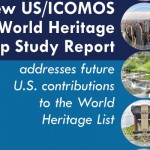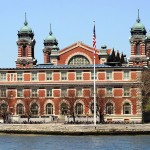
Credit: Jim Henderson Wikipedia Commons
World Heritage designation connotes that a property is of outstanding universal value and is seen as the gold standard of global significance. However, this appellation is not as well known or sought after in the United States as in most other countries where designation is seen as a source of national pride, a potential ticket to more state support, and a possible economic benefits from increased tourism. For this reason, in many countries proponents of a World Heritage nomination invest serious dollar and even political capital in preparing a bid for World Heritage inscription.
The first step in the process is for a state party to create a tentative list of potential World Heritage candidates. Recently the United States updated its tentative list. This is a big deal as the last US tentative list was a prepared in 2008. With little public fanfare, the US Department of the Interior has added five new cultural properties to the United States’ World Heritage Tentative list. The new list was published in the Federal Register in early December 2016 with a brief 15 day comment period and is now final. The updated and complete tentative list of both the US cultural and natural properties is available on the web sites above.
 While in the past the preparation of the US tentative list was the bailiwick of a small group of experts, starting in 2015 the National Park Service broadened the outreach process for cultural properties. The agency partnered with US ICOMOS to conduct an online expert consultation, which reached out to almost a 1,000 architects, historians, archaeologists, site managers, ethnographers, Tribal Historic Preservation Officers, State Historic Preservation Officers and their expert staff. Respondents were surveyed to identify their area of expertise, familiarity with World Heritage program, and related topics. A central component of the consultation was an expert discussion forum of six threaded topic areas. Each topic area was moderated by at least two experts who posed questions and encouraged a robust online discussion.
While in the past the preparation of the US tentative list was the bailiwick of a small group of experts, starting in 2015 the National Park Service broadened the outreach process for cultural properties. The agency partnered with US ICOMOS to conduct an online expert consultation, which reached out to almost a 1,000 architects, historians, archaeologists, site managers, ethnographers, Tribal Historic Preservation Officers, State Historic Preservation Officers and their expert staff. Respondents were surveyed to identify their area of expertise, familiarity with World Heritage program, and related topics. A central component of the consultation was an expert discussion forum of six threaded topic areas. Each topic area was moderated by at least two experts who posed questions and encouraged a robust online discussion.

By Ingfbruno; CC BY-SA 3.0, https://commons.wikimedia.org/w/index.php?curid=29079811
The six selected cultural resource themes for the consultation were not just based on disciplinary categories, but attempted to address the recognized gaps in the existing US World Heritage tentative list as well as identified gaps and lack of representation in the overall World Heritage list. The full list of the selected themes can be found at the end of the article. Over one hundred experts contributed their ideas and suggested representative properties. Such an ambitious approach to consultation had never been tried before. Based on this information US/ ICOMOS issued a synthesis of these findings, U.S. World Heritage Gap Report.
This information was further reviewed by an experts round-table and all this information was shared with the US National Park Service as part of developing the final recommendations for the recent tentative list.
The first question that might be asked is – did this process make a difference? How many of the themes and specific examples identified in the US/ICOMOS Gap report were included in the expanded tentative list? Or to put in another way, did the process help make our nation’s tentative list more representative? Well let’s take a look at the recommendations.
Brooklyn Bridge, New York
There was high level of consensus under the theme of Technology and Industry and the sub theme of Auto Industry & Transport that more examples in these categories needed to be included on the tentative list. And no surprise, the Brooklyn Bridge was a identified as a stand-out example of outstanding universal value. The bridge was called out multiple times in the report under the theme of Industry, but also under the theme of Architecture and Innovation
Central Park, New York
The topic of cultural landscapes attracted the most commentators in the consultation. The discussion under this theme were categorized into broad areas two dealing with African American culture and plantation landscapes and African American Civil Rights sites and another in a different vein looked at designed parks and protected areas and specifically the development of the US national park system. It is in this category that Central Park in New York City was the preeminent example not just as inspiring other city parks, but later the creation of scenic reservations and national parks.
Early Chicago Skyscrapers Illinois
Another underrepresented theme dealt with Architecture and Urbanism and in particular the sub theme of innovation, technology and scientific development in the field. The skyscraper as a type, particularly the innovations that began in Chicago, were repeatedly identified as an important resource.
Ellis Island, New Jersey and New York
At both the global level and in the US, properties related to the theme of Living Cultures and Diverse heritage are underrepresented types on the World Heritage list. The sub-theme of migration and globalization was identified as one of great international relevance. And Ellis island is one of the best known symbols of both migrants to the US and to the families left behind.
Moravian Bethlehem, Pennsylvania
Also under the theme of Living Cultures and Heritage was the Moravian community in Bethlehem Pennsylvania. Founded in 1741, the site was part of a closely knit world-wide network espousing the greater good of a world community.
As might be foreseen, a number of themes and representative properties discussed in the gap report could not be included in the most recent US tentative list. However, it should be noted that the five new additions to the list were all identified in the US/ICOMOS report and provide some diversity to the list. For example, adding more places of recent history, technology and innovation, and world migration and immigration. While the list is tilted towards the Eastern Seaboard and New York City specifically, it does offer some counter balance to the western slant of the 23 World Heritage sites in the US inscribed to date. It does a good job of working around the limitations that hobble many US proposals including the requirement for the written consent of all property owners.
In conclusion, this online consultation has had collateral benefits. For one thing, it was a once in a decade chance to engage interested practioners and academics in the US directly with the World Heritage program. And did so in a cross disciplinary manner. It was also an opportunity to introduce the professional community to the World Heritage process and of course to US/ICOMOS as the country’s preservation organization with a global focus. Given are current political climate in the US, some persons have suggested that our discussion of World Heritage should be played down. However, I think that this is an exceptional opportunity to engage with proponents of new world heritage sites and to promote the ideas for which they stand as part of a much needed international dialogue.
List of Themes and queries:
ARCHAEOLOGY & ANTHROPOLOGY: Are there types, regions or periods of Archaeological sites or landscapes that are underrepresented on the current list?
ARCHITECTURE & URBANISM: What types of urban heritage and architectural ensembles of outstanding universal value could address gaps of underrepresented typology, region or period?
TECHNOLOGY & INDUSTRY: What opportunities exist to address gaps related to Science, Technology, Invention and Industrial Heritage?
LIVING CULTURES & HERITAGE, two questions were asked: Are there living cultures, subcultures and examples of America’s diverse heritage that have been qualitatively underrepresented? Are there themes of migration, settlement, modes of subsistence, human interaction, cultural coexistence, spirituality and creative expression in the US that have been qualitatively underrepresented?
CULTURAL LANDSCAPES: What types of Cultural Landscapes in the US are responsive to the gaps identified on the World Heritage List, for living landscapes in particular.



4 Responses
Although the list is wonderful and to tskenothing away from the sites, it is a bit sad that none of the National Heritage Areas were selected for the tentative list of WorldHeritageAreas!?
Yes National Heritage Areas contain many cultural resources and landscapes worthy of World Heritage consideration. However, as noted in the article the United States is hobbled by the Congressional requirement that to be inscribed on the World Heritage list every property owner within the nomination must consent. This is a high barrier for large and complex properties.
Thank you for your comment!
Don’t forget. Bethlehem, PA is within the Delaware & Lehigh Heritage Corridor in Pennsylvania. Chicago is within the I & M Canal NHA. The three sites in New York City are not far from the Hudson River Valley NHA, which has its southernmost tip on the Hudson River near Yonkers, New York. So, 2 out of 5 are within existing NHAs.
Thank you Marilyn…Good comments!